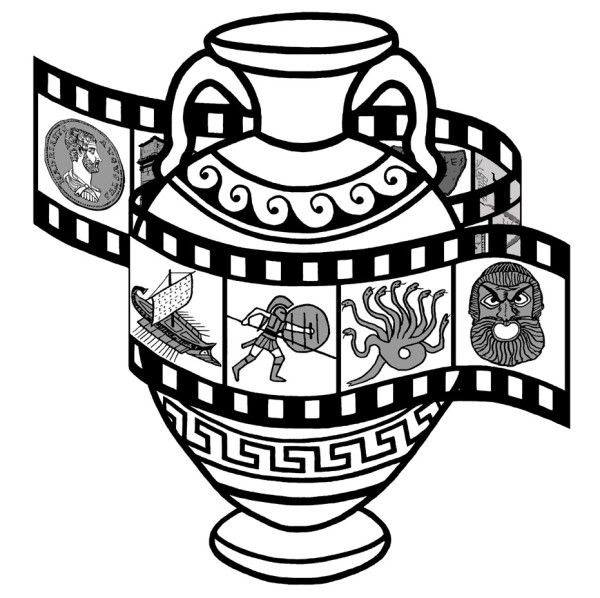About
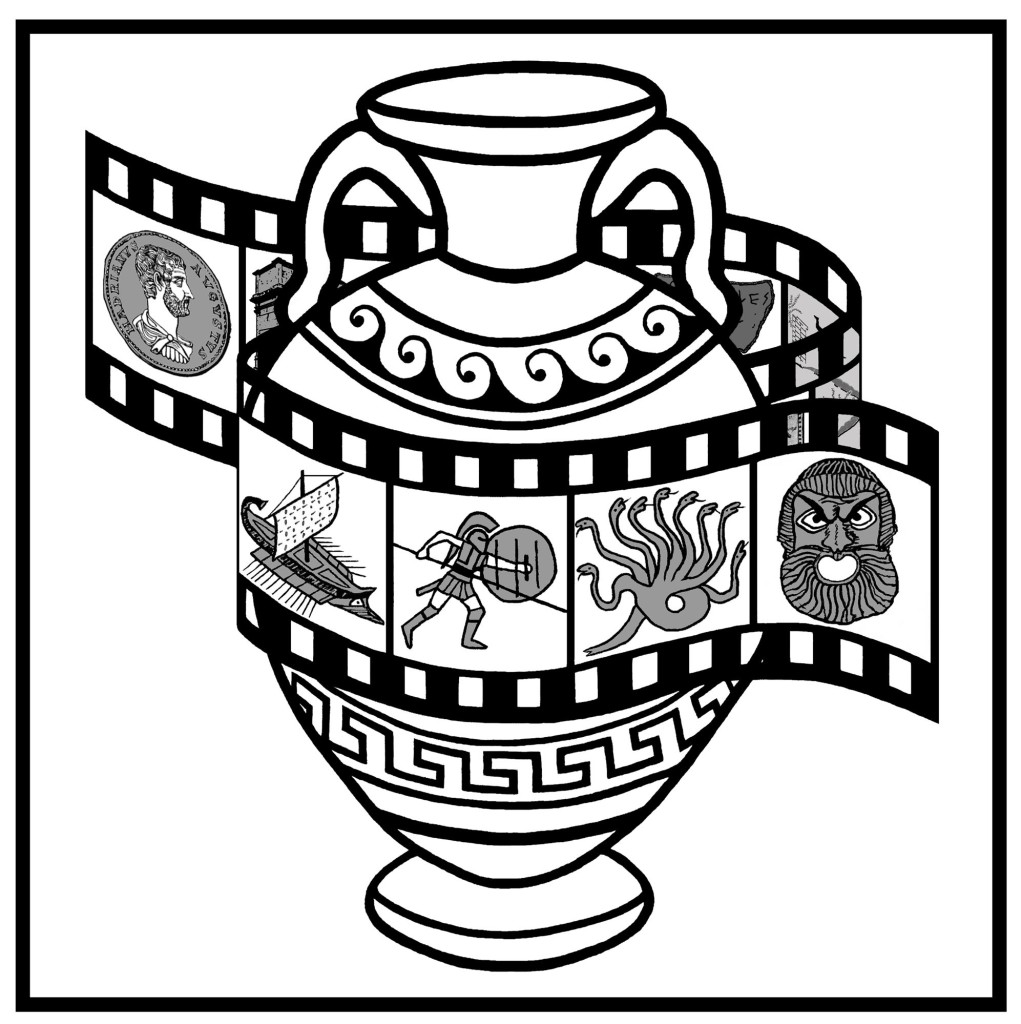 We are a cross-disciplinary and international research network interested in the dialogues between the Ancient and the Modern worlds. Our focus of attention is the reception of Antiquity in the visual and performing arts and more generally in visual culture and media in all its renderings and representations.
We are a cross-disciplinary and international research network interested in the dialogues between the Ancient and the Modern worlds. Our focus of attention is the reception of Antiquity in the visual and performing arts and more generally in visual culture and media in all its renderings and representations.
Imagines 8
Pagan Pornotopias?
The Reception of Antiquity in Eroticism and Pornography
Madrid, 27-29 September 2023
Programme
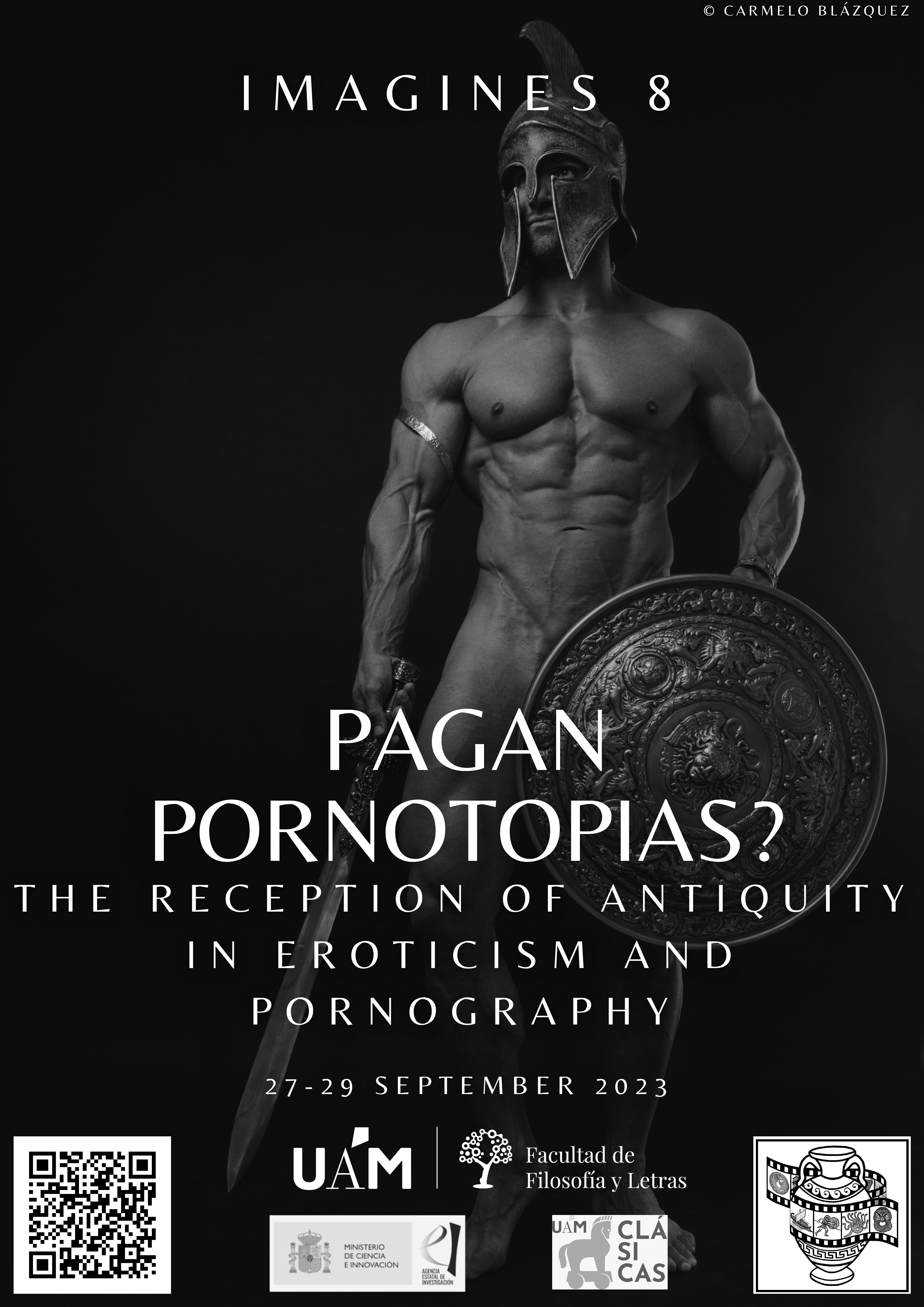
Wednesday, September 27
Place: Centro Cultural La Corrala (Salón de Actos). C/ Carlos Arniches, 3-5
14.00 Registration - Coffee
15.00 Conference Opening – Greetings of the Authorities
Filippo Carlà-Uhink (Potsdam) & Luis Unceta Gómez (Madrid), Introduction
Panel 1: What Aroused Our Forefathers and Foremothers? Antiquity in 18th and 19th Century Eroticism
Chair: Filippo Carlà-Uhink (Potsdam)
15.30 Katherine Harloe (London), Practical Enlightenment: Pagan Pornotopia in Casanova’s Encounter With Winckelmann
15.55 Athena Leoussi (Reading), ‘La joie de vivre’: Modern Hellenism and the Revival of the Life of the Senses
16.20 Discussion
16.45 Coffee Break
17.15 Nikolai Endres (Bowling Green), A Pornotopia in Sicily? The Baron von Gloeden’s Reception of Antiquity
17.40 Stefania Arcara (Catania), “Dark, Virulent, Divine”: the Fin-de-Siècle invention of Sapphic Eroticism in Britain
18.05 Discussion
18.30 Imagines Group Meeting – only for members of Imagines
Thursday, September 28
Place: Facultad de Filosofía y Letras (Salón de Actos). Universidad Autónoma de Madrid
Panel 2: Ancient Models for Modern Sex
Chair: Irene Berti (Heidelberg)
09.00 Anastasia Bakogianni (Auckland), Can Greek Tragic Heroines Ever be Sexy? Eroticism vs. Female Revenge
09.25 Thomas E. Jenkins (San Antonio), Getting to the Bottom of Rufus Wainwright’s Hadrian: Identity and Bravery in Contemporary Opera
09.50 Anise Strong (Kalamazoo), Ancient Sexuality and Modern Video Games
10.15 Discussion
10.45 Coffee Break
Panel 3: So We Dare Speak Its Name: Antiquity in (and for) Homosexual and Queer Desire
Chair: Luis Unceta Gómez (Madrid)
11.15 Filippo Carlà-Uhink (Potsdam), Performing Doric and Ionic Love: Ancient Greece in Gay Male Pornography
11.40 Patricia A. Gwozdz & Markus Lenz (Potsdam), Subversive Hercules. How to Fashion Queer Desire in Popular Culture and Instagram
12.05 David Delbar (Chicago), Domination and the Minotaur
12.30 Discussion
13.00 Lunch
Panel 4: Spatialisations of Lust: Sexualised Antiquity in Architecture and Decoration
Chair: Marta García Morcillo (Durham)
14.30 Jean-Noël Castorio & Stephanie Ferrand (Le Havre), The Monuments of the «Captain Storm» and the Neoclassical Erotism
15.00 Sanja Vucetic (Sheffield), Classical Greek Images of Sex as Modern ‘Adults Only’ Souvenir Art
15.25 Jorge Elices Ocón (Madrid), Marble Breasts and Phalli of Stone: Classical Statues as Erotic Reference and Pornographic Transgression in the Islamic World
15.55 Discussion
16.15 Coffee Break
16.45 Ricardo del Molino (Bogotá), El clasicismo de burdel en América Latina. La antigüedad egipcia, griega y romana en prostíbulos, moteles y hoteles de tránsito hispanoamericanos
17.10 Tanja Kilzer (Siegen), “Sexy Goddesses and Handsome Gladiators” – Eroticized Stereotypes of the Antiquity in the US-American Hotel Business of Jay Sarno in the 1960s
17.35 Discussion
18.00 Coffee Break
18.30 Carmelo Blázquez Jiménez (Barcelona), De héroes y efebos. Referencias clásicas en mi fotografía
Friday, September 29
Place: Facultad de Filosofía y Letras (Salón de Actos). Universidad Autónoma de Madrid
Panel 5: Antiquity Goes Hard: Greece, Rome and the Pornography Debate
Chair: Anja Wieber (Dortmund)
09.00 Martin Lindner (Göttingen), X-Rated Classics – Cinematic Antiquity and the Impossibility to Classify Pornography
09.25 Alastair Blanshard (Brisbane), But Is It Pornography? Locating Obscenity in the Classicising Photographs and Films of Mid-Century Physique Culture
09.50 Florian Freitag (Essen), Traditions Revisited and Continued: Antiquity in the new Physique Pictorial
10.15 Discussion
10.45 Coffee Break
11.15 Charlotte Gregory (London), The Dynamics of Interracial Pornography in Troy: Fall of a City (2018)
11.40 Anna Socha (Liverpool), The Iliad 2: A (Very) Dirty Story. Sexualised Retelling of the Iliad and Odyssey
12.05 Luis Unceta Gómez (Madrid), Pagan Pornotropes. Ancient Rome and the Erotics of Power in Pornographic Comic Books
12.30 Discussion
13.00 Final Discussion and Conclusions
13.30 Lunch
....
To attend in presence or online, please register by sending an email to This email address is being protected from spambots. You need JavaScript enabled to view it..
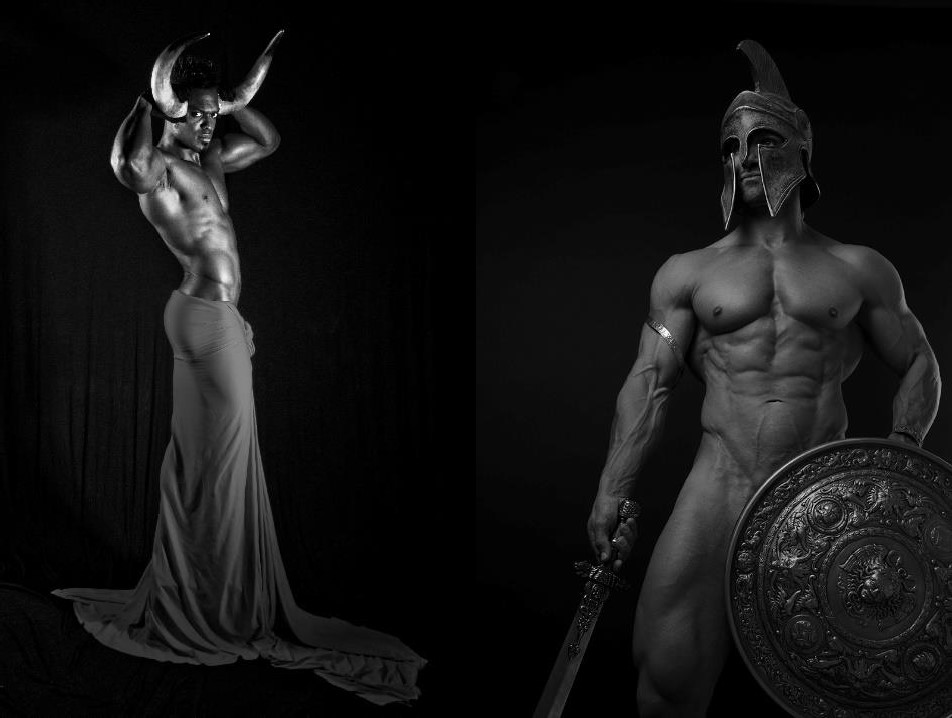
© Carmelo Blázquez
Pagan Pornotopias?
The Reception of Antiquity in Eroticism and Pornography
Madrid, 27.-29 September 2023
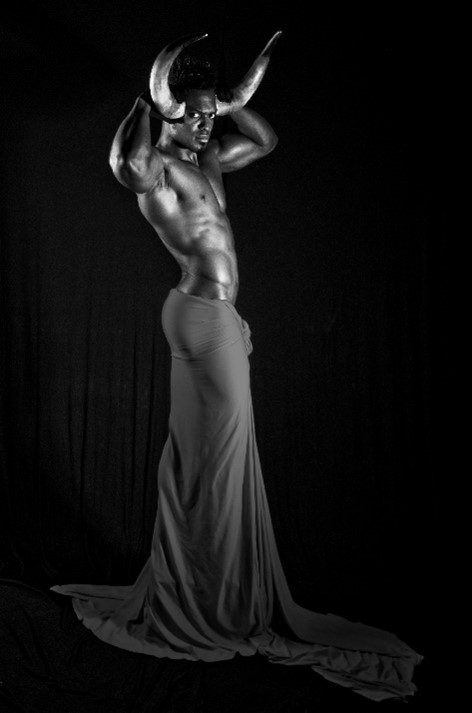
© Carmelo Blázquez
The eighth conference of the Imagines group, which will take place at the Universidad Autónoma de Madrid (Spain) on September 27th-29th, 2023, will be dedicated to the reception of ancient cultures, especially Greece and Rome, in eroticism and pornography from the 19th century to the present. Consistently with the main research aim of the Imagines group (https://www.imagines-project.org/), the focus will be on the reception of the ancient world in visual and performative erotic and pornographic productions (a discussion at theoretical level of characters of and differences between eroticism and pornography is also welcome, within the conference’s main topic, the reception of Antiquity).
It has been recently pointed out that ancient Rome indeed can be defined in the modern Western popular culture as a “pornotopia”, in which the most diverse and deviant form of sexual practice and desire can be located. An important aspect of this eroticised characterisation of ancient Rome is its implicit opposition to Christian morality (and sexual repression), which derives from the narratives of Christian chastity and martyrdom that have been so widespread and relevant in Western cultural memory since the Middle Ages. Yet this is not the only reason that has fostered a markedly erotic relationship between the modern times and the ancient world. At the same time, indeed, ancient Greece has played a crucial role in constructing and legitimating same-sex attraction – and Plato (and in particular Aristophanes’ speech in the Symposium) has been deployed since the 19th century to provide the – particularly male – gay community with a legitimating narrative within the frame of European philhellenism. As formulated in 1961 by ONE magazine for example, “almost the first thing that any [male] homosexual does, when called upon to offer any serious defense of homosexuality, is to draw upon the glorious example of the manly Greek warriors and athletes who apparently practiced homosexual love openly and without shame”. Similarly, ancient historical or mythological figures such as Sappho or the Amazons have been deployed to shape and legitimise female homosexual identity. Other ancient peoples – the Persians, the Egyptians, the Etruscans, just to name some examples – have been portrayed since Antiquity and through typical mechanisms of Othering as sexually deviant from the assumed “norm”; this has also filtered into modern receptions, which often replicate, translate and modify the Orientalist stereotypes already widespread in the ancient world (one can think of the representation of the Persians as “sexually deviant” in the blockbusters 300 and 300: Rise of an Empire).
The aim of this conference is to investigate the role played by the ancient world in shaping erotic and pornographic representations, and thus in representing and structuring attraction and desire. This analysis will help in understanding how references to Antiquity play, at a more or less conscious level, a crucial role in defining, stereotyping, constructing in discourse and legitimating sexual identities, sexual orientations, gender belonging and performance.
Confirmed speakers include, together with the organisers and editors of the volume, Luis Unceta Gómez (UAM) and Filippo Carlà-Uhink (Universität Potsdam): Anastasia Bakogianni (Massey University), Alastair Blanshard (The University of Queensland), Thomas Jenkins (Trinity University), Athena Leoussi (University of Reading), Martin Lindner (Universität Göttingen), Anise K. Strong (Western Michigan University).
See conference programme and abstracts.
The conference programme will also include a meeting and public discussion with Carmelo Blázquez, an internationally renowned photographer specializing in male nude photography (https://www.carmeloblazquez.com/).

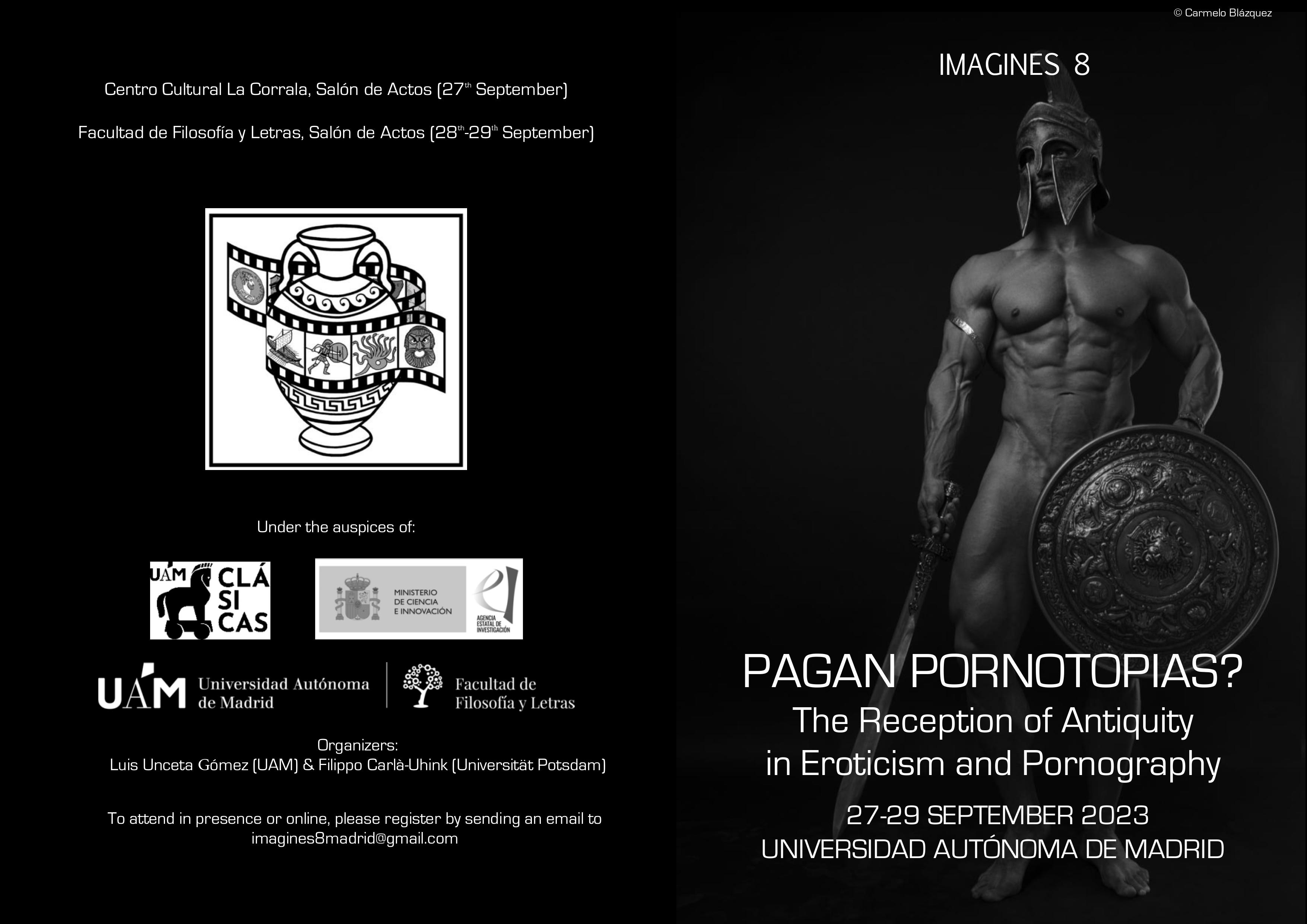
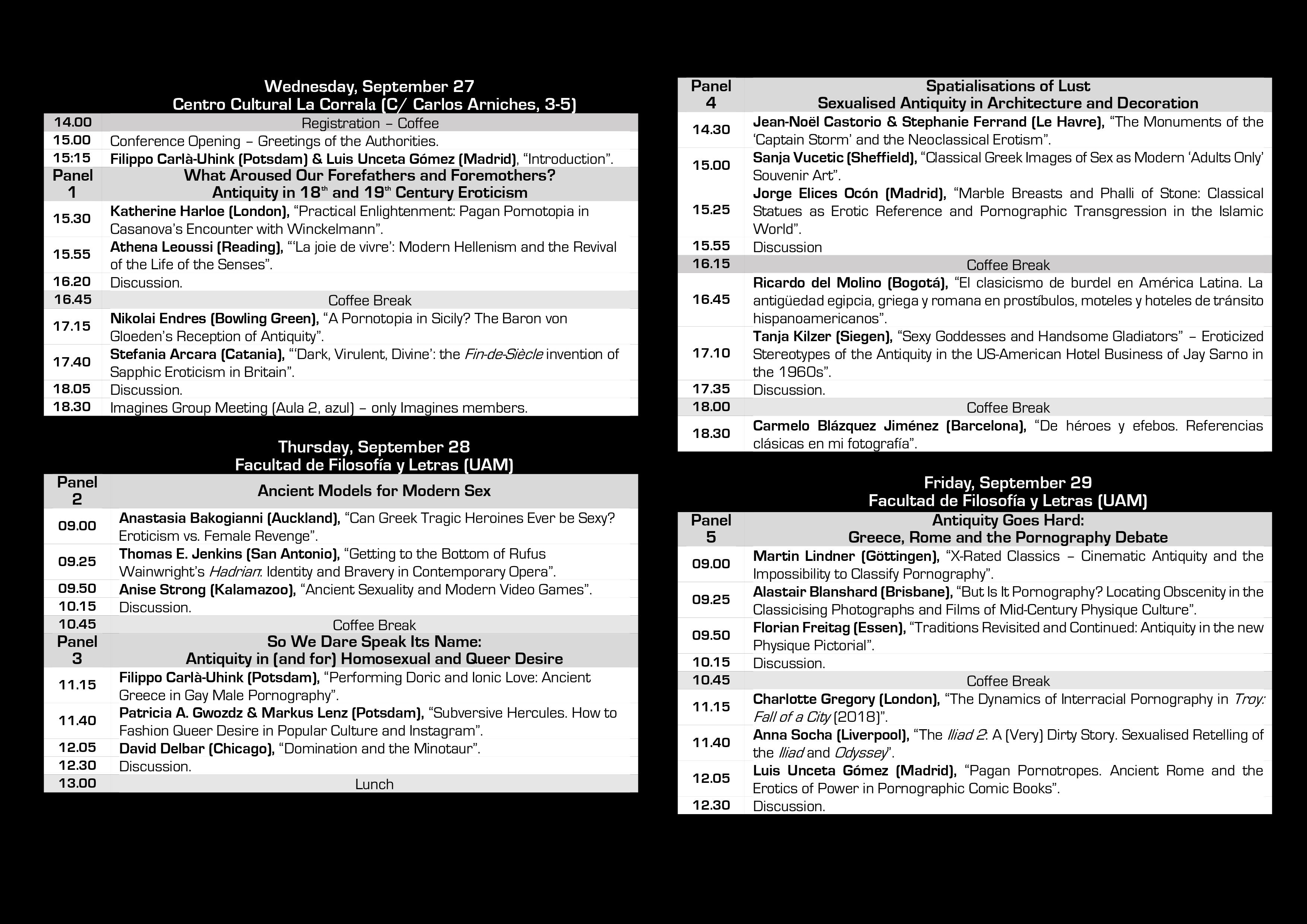
© Carmelo Blázquez


The Imagines logo integrates in one single design the interaction between different artistic expressions that shapes our project. A logo is an image that synthesises a concept. In this case, the challenge was to create a recognising concept that could transmit the idea of the dynamic dialogue between the ancient and the modern mediated by the arts. The logo is the outcome of the creative research and design work of our collaborators from Barcelona Ainize González and Nacho García, both art historians.
 Making of: The starting point that triggered the design was to find an element that through movement could express and link transversality and intermediality, both key concepts that define the work and aims of our research network. Figure 1 shows a still very schematic sketch of a celluloid, a tool that embodies both movement and image.
Making of: The starting point that triggered the design was to find an element that through movement could express and link transversality and intermediality, both key concepts that define the work and aims of our research network. Figure 1 shows a still very schematic sketch of a celluloid, a tool that embodies both movement and image.
 On the next image (Fig. 2) we see a prototypical Greek amphora surrounded by celluloid that includes several ancient motives. Painting, theatre, dance and mythology are represented in this proto-design.
On the next image (Fig. 2) we see a prototypical Greek amphora surrounded by celluloid that includes several ancient motives. Painting, theatre, dance and mythology are represented in this proto-design.
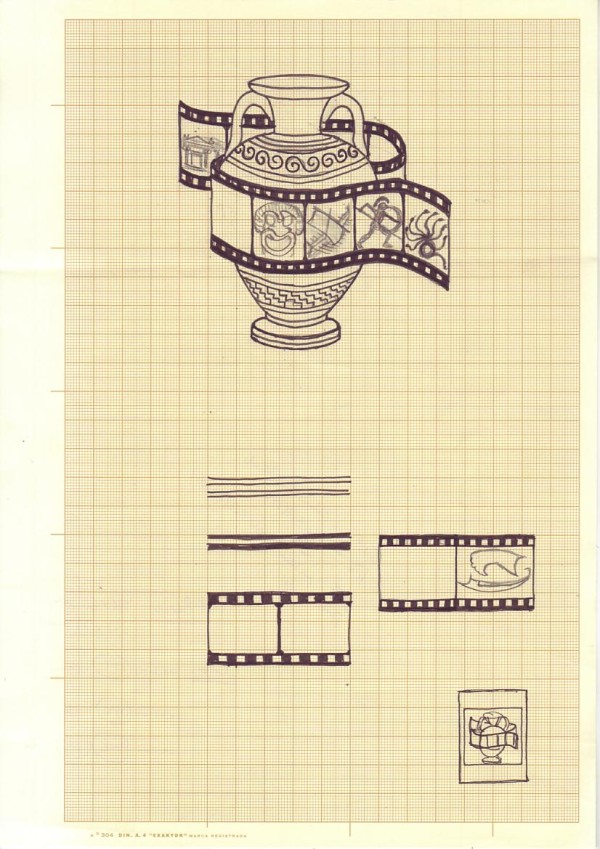 The next illustration (Fig. 3) expands this idea and displays the definitive proportions of the celluloid. Some geometric motives have been added on the amphora. The choice of the amphora is explained by its double functionality both as a pictorial support and as an artistic object per se.
The next illustration (Fig. 3) expands this idea and displays the definitive proportions of the celluloid. Some geometric motives have been added on the amphora. The choice of the amphora is explained by its double functionality both as a pictorial support and as an artistic object per se.
 Fig. 4 brings together the concepts that had been considered in previous phases, but still does not whow a coherent narrative.
Fig. 4 brings together the concepts that had been considered in previous phases, but still does not whow a coherent narrative.
On the following illustration (Fig. 5), proportion and symmetry are aligned and one of the frames is removed in order to improve the geometric harmony of the design.
Figure 6 displays the definitive design. At both ends of the celluloid we see two static motives while those depicting dynamic elements occupy the centre of the composition, which aims to enhance movement to the object. The choice of these motives took into consideration the research interest of members and collaborators of Imagines.
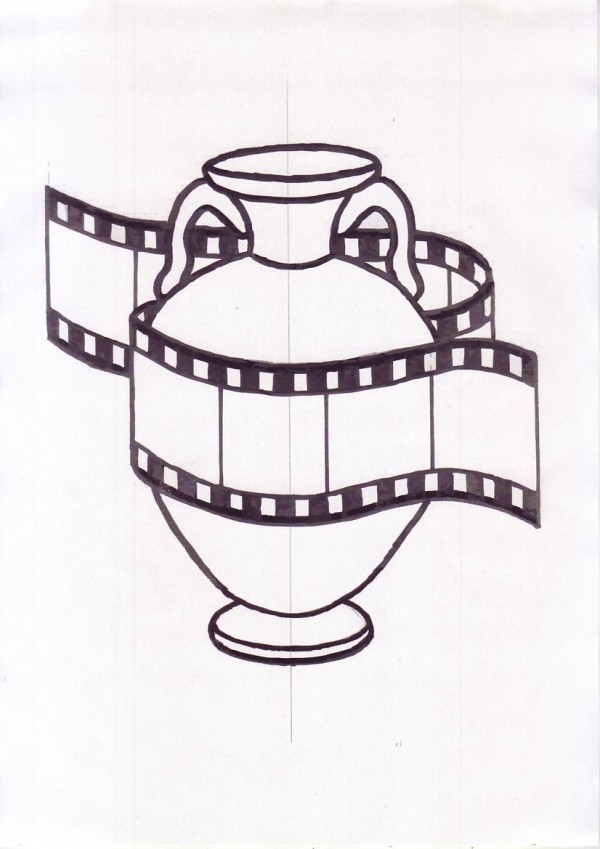 Performing arts and sculpture are represented by a theatrical mask; the Arch of Titus features monumental and urban architecture; the Hadrianic coin stands out as a symbol of the Roman Empire; it epitomises “official art” and the iconographies of power; the ship symbolises the ancient Mediterranean as a place of cultural encounters, travelling and dialogue; the inscription is the testimony of the memory of the past, while the painting and the mosaic perform not only as ornaments, but also as narrative elements that mirror society and everyday life.
Performing arts and sculpture are represented by a theatrical mask; the Arch of Titus features monumental and urban architecture; the Hadrianic coin stands out as a symbol of the Roman Empire; it epitomises “official art” and the iconographies of power; the ship symbolises the ancient Mediterranean as a place of cultural encounters, travelling and dialogue; the inscription is the testimony of the memory of the past, while the painting and the mosaic perform not only as ornaments, but also as narrative elements that mirror society and everyday life.
Finally, the red- and black-figure motives, which are inspired by the iconography of real Greek kraters, exemplify the central place that mythology plays both in Antiquity and in Classical Reception.
The image below is a diagram that comprehends all these ideas and displays the specific iconographic sources that inspired the figures.

 The logo fits into a frame that also includes a new typography. This element found its inspiration in the revolutionary designs of the Wiener Werkstätte, a strand of the famous fin-de-siècle Secessionist movement that aimed to unify the practical and the aesthetical. The typography, which is called Archeologicaps, has been created by the designer Manfred Klein, and presents reminiscences of Roman monumental epigraphy.
The logo fits into a frame that also includes a new typography. This element found its inspiration in the revolutionary designs of the Wiener Werkstätte, a strand of the famous fin-de-siècle Secessionist movement that aimed to unify the practical and the aesthetical. The typography, which is called Archeologicaps, has been created by the designer Manfred Klein, and presents reminiscences of Roman monumental epigraphy.
The Imagines logo features also now very nicely on the beautiful covers of the Imagines book series volumes, published by Bloomsbury (link to the series):
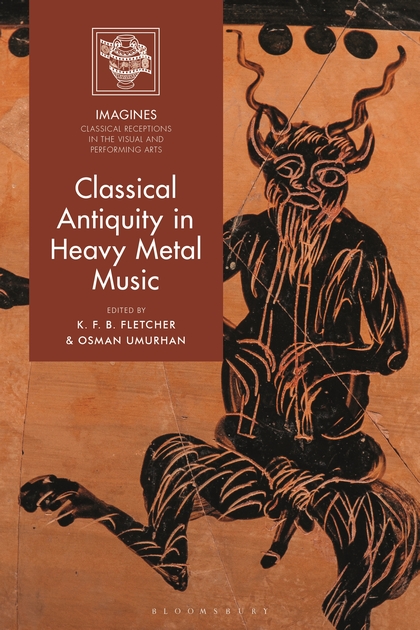
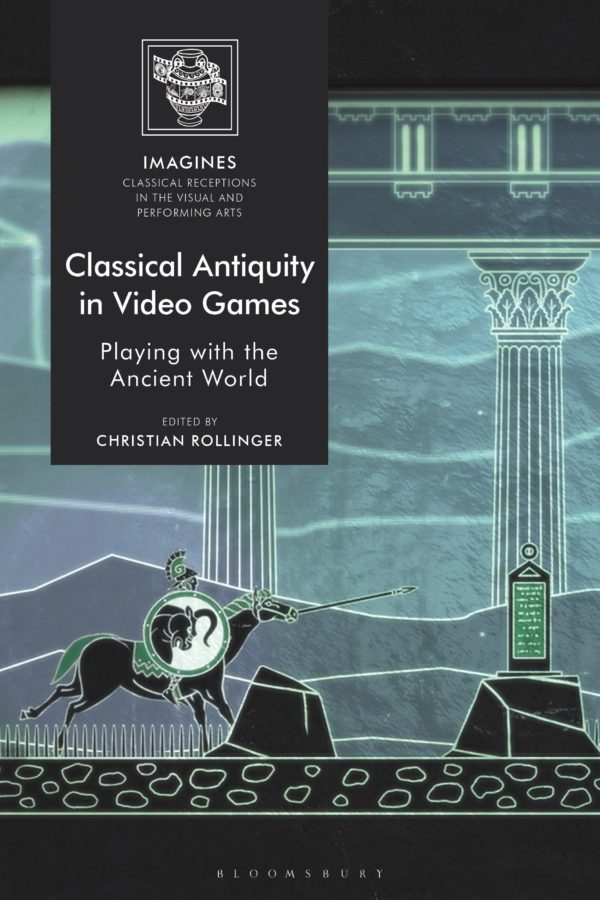
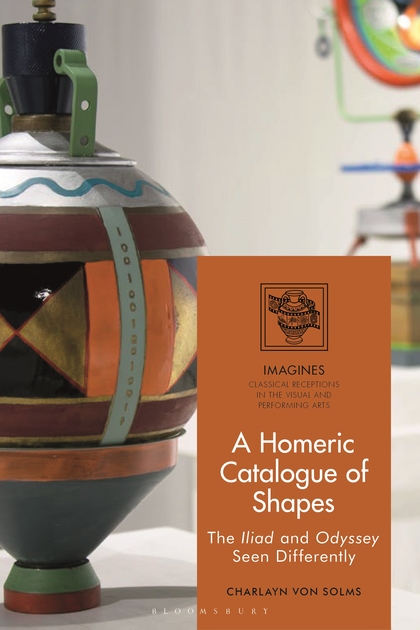
Page 1 of 2
News & Events
-
Antiquity in silent films from the Tom Stern Collection
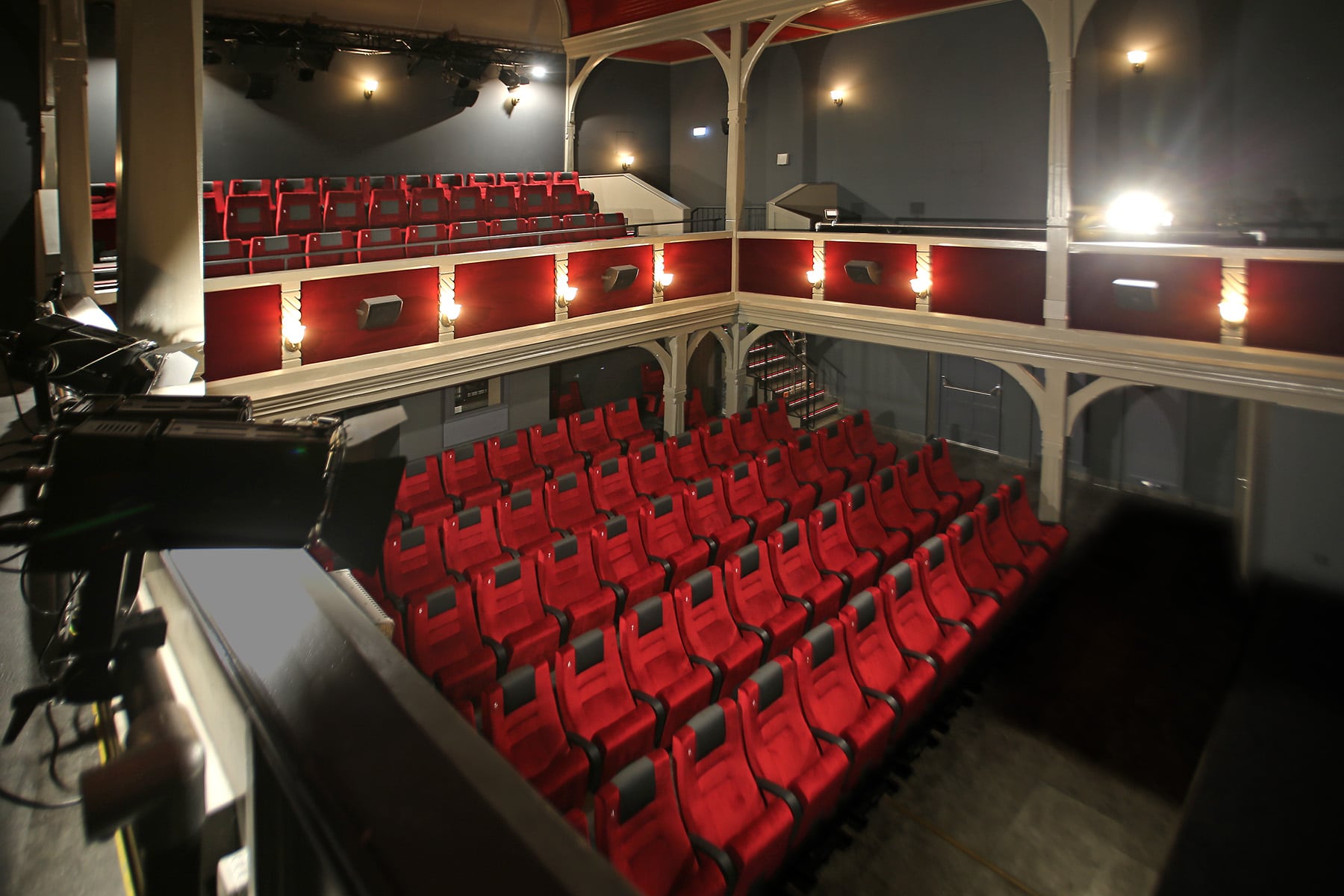
Antiquity in silent films from the Tom Stern Collection shown at the 5th Göttingen Night of Science (5 July 2022) Cinema Méliès, Göttingen
-
Conference: Performing Ancient Greek Literature in a Time of Pandemic (23-24 June 2022)
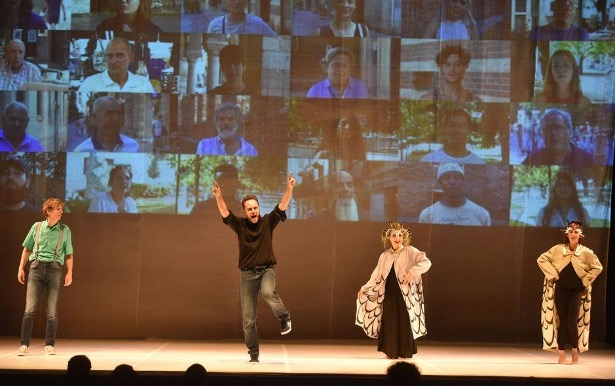
Organizers: Anastasia Bakogianni (Massey University, New Zealand) and Barbara Goff (University of Reading, UK)
-
Lecture and Workshop: Greek and Roman Antiquity for Children and Young Adults, Potsdam 5 and 7 July 2023

LECTURE GIRL TO WOMAN: THE MYTH OF PERSEPHONE IN YOUNG ADULT FICTION Cristina Salcedo González Universidad Complutense de Madrid 5th July 2023 / 18.00 CAMPUS Am Neuen Palais House 9 / Room 1.02 This lecture investigates the representation of a very popular figure from ancient myth, Persephone, in young adult fiction, analysing a series of examples from a range of anglophone cultures and contexts (New Zealand, South Africa, UK and USA). It will be shown that Persephone can represent and cover a broad range of diverse actual issues, ranging from LGBTQI+ desire to eating disorders, from partner violence to parental mental health, from PTSD to caring responsibility. Through Persephone’s example it will be shown how relevant Greek mythology still is in contemporary cul- ture – and specifically in the entertainment and forma- tion of young adults in the anglophone world. WORKSHOP GREEK AND ROMAN ANTIQUITY FOR CHILDREN AND YOUNG ADULTS 7th July 2023 / 10.00 WIS Bildungsforum Potsdam 10.00...
-
New: Imagines Book series, Vol. 14

Volume 14 of the Imagines book series announced The Reception of Cleopatra in the Age of Mass Media by Gregory N. Daugherty
-
News. Coming event. Imagines 8. Pagan Porntopias? Poster and Programme, Madrid 27-29 Sep. 2023

News: Imagines 8 is coming! Here the poster, programme, and information to attend: Pagan Pornotopias? The Reception of Antiquity in Eroticism and Pornography, Madrid, 27 to 29 September 2023.

